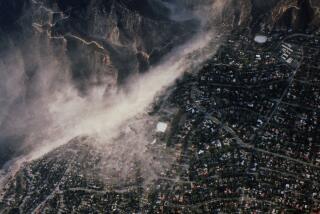Op-Ed: Funiculars like Angels Flight don’t just have to be for tourists
Angels Flight has sat idle since 2013 — the third time in the last 15 years that L.A.’s famous funicular railway has been shut down because of safety concerns. The worst incident occurred in 2001 when one of the cars careened out of control down the tracks, apparently because a cable unraveled. One rider was killed and seven were injured in the crash.
Given this rap sheet, it’s understandable that Angelenos are hesitant to see Angels Flight up and running again — let alone eager to build additional funiculars or other forms of cable-propelled transit around the city. But in Southern California, a region where getting to your final destination is often a vertical challenge, it makes perfect sense to incorporate CPTs into the transportation system.
On the whole, funiculars are safe. Several older cities in the United States operate historic funiculars, including Pittsburgh and Dubuque, Iowa, without incident.
Connecting Dodger Stadium to Union Station would require a gondola very similar in scale to the Portland Aerial Tram.
Modern European CPTs have boasted high ridership for years with only a handful of problems. By far the most extreme was a fire on an Austrian funicular in 2000 that killed more than 100 riders. But accidents are possible no matter what the mode of transit. (Each year, tens of thousands of Americans die in their cars.) The Funiculaire de Montmartre in Paris carries more than 2 million passengers a year and has an impeccable record.
Setting aside safety concerns, many Americans dismiss CPTs as novelties or tourist traps. This view, however, ignores how very useful they are in topographically challenged cities such as Los Angeles. CPTs can provide transit connections to hard-to-reach places without requiring large-scale, disruptive construction — no small advantage.
Medellin, Colombia, introduced several gondola lines in 2004 to serve poor neighborhoods on steep hillsides. In 2007, Portland, Ore., opened a gondola system that connects the Oregon Health & Science University campus, on a crowded hilltop, to the city’s light-rail and streetcar network. The Portland Aerial Tram cost $57 million to build — the university put up most of the money — and now carries 3,000 passengers a day. Not only has the tram alleviated parking and traffic congestion at the top of the hill, it has stimulated a development boom at the bottom.
As traffic congestion worsens throughout Southern California, more people will seek alternatives to driving. But in many cases they’re likely to run into a vertical challenge that makes walking or even riding the bus difficult and time-consuming.
Vertical transportation alternatives may seem far-fetched, but if placed strategically they could help people reach popular destinations. Connecting Dodger Stadium to Union Station would require a gondola very similar in scale to the Portland Aerial Tram. What about a connection from Palisades Park to the beach in Santa Monica — about the same drop as Montmartre? San Diego County Supervisor Ron Roberts has suggested a gondola from downtown San Diego to Balboa Park. Frankly, there’s no other good way to deposit people in the middle of the park’s Central Mesa efficiently without a car — and, as with Dodger Stadium, the vertical and horizontal distances are similar to Portland’s.
Maybe with more safety measures, even Angels Flight will reopen someday and connect Bunker Hill via public transit to the rest of Los Angeles. It’s a pretty easy transfer from the Red Line station at the bottom of the hill and a long walk up the stairs.
William Fulton is director of the Kinder Institute for Urban Research at Rice University and author of “The Reluctant Metropolis: The Politics of Urban Growth in Los Angeles.” Kyle Shelton is a postdoctoral fellow at the Kinder Institute and author of the forthcoming “Power Moves: Infrastructural Citizenship in Houston, Texas, 1950 to Today.”
Follow the Opinion section on Twitter @latimesopinion and Facebook
More to Read
A cure for the common opinion
Get thought-provoking perspectives with our weekly newsletter.
You may occasionally receive promotional content from the Los Angeles Times.










